Accounting Assignment: ST Energy Ltd - Financial Analysis
VerifiedAdded on 2022/11/18
|22
|2554
|91
Homework Assignment
AI Summary
This document presents a comprehensive solution to an accounting assignment, addressing various financial reporting and accounting principles. The assignment delves into fair value measurement, adhering to NZ IFRS 13, and analyzes different scenarios to determine fair value based on market conditions and participant usage. It covers the revaluation of assets using the gross method and examines the accounting treatment of damaged equipment, including journal entries. Furthermore, the solution explores intangible assets, specifically patents, and their amortization, alongside the accounting for research and development projects. The assignment also includes detailed calculations of taxable profit, tax payable, and deferred tax, with corresponding journal entries, as well as the classification of financial instruments. Finally, it provides calculations related to loan repayment schedules.

Running head: ACCOUNTING
Accounting
Name of the student
Name of the university
Student ID
Author note
Accounting
Name of the student
Name of the university
Student ID
Author note
Paraphrase This Document
Need a fresh take? Get an instant paraphrase of this document with our AI Paraphraser

1
ACCOUNTING
Table of Contents
Question 1........................................................................................................................................2
Fair Value Measurement..............................................................................................................2
Revaluation using gross method..................................................................................................3
Damaged Equipment....................................................................................................................4
Intangible Assets..........................................................................................................................7
Usage of patents in the manufacturing process............................................................................7
Research and development project..............................................................................................7
Question 2........................................................................................................................................9
Answer (a)....................................................................................................................................9
Answer (b)....................................................................................................................................9
Answer (c)..................................................................................................................................11
Answer (d)..................................................................................................................................12
Question 3......................................................................................................................................14
Answer (a)..................................................................................................................................14
Answer (b)..................................................................................................................................14
References..................................................................................................................................17
ACCOUNTING
Table of Contents
Question 1........................................................................................................................................2
Fair Value Measurement..............................................................................................................2
Revaluation using gross method..................................................................................................3
Damaged Equipment....................................................................................................................4
Intangible Assets..........................................................................................................................7
Usage of patents in the manufacturing process............................................................................7
Research and development project..............................................................................................7
Question 2........................................................................................................................................9
Answer (a)....................................................................................................................................9
Answer (b)....................................................................................................................................9
Answer (c)..................................................................................................................................11
Answer (d)..................................................................................................................................12
Question 3......................................................................................................................................14
Answer (a)..................................................................................................................................14
Answer (b)..................................................................................................................................14
References..................................................................................................................................17

2
ACCOUNTING
Question 1
Fair Value Measurement
1. Paragraph 16 of NZ IFRS 13 suggests a transaction always takes place primarily in the
principal market and only in the case of absence of a principal market, it takes place in the
most advantageous market. Paragraphs 25 and 26 of NZ IFRS 13 suggest that the fair
value amount shall not be adjusted for transaction costs. This is because transaction costs
are not a characteristic of the asset or the liability (Dvořáková, 2013). Transportation costs
are allowed as a deduction. A company cannot choose to measure a product in the value of
an advantageous market when there is a principal market. In scenario 1, the amount that is
to be considered as fair value is the price prevailing in the principal market, i.e. Market A.
Hence the fair value of the asset in the given scenario is $158440 ($160000-$1560). In
scenario 2, the price that is to be considered is the price prevailing in the most
advantageous market. Therefore, in scenario 2, the fair value of the asset is to be measured
at $236800 ($240000-$3200). Hence, it is considered the most advantageous market
(Xrb.govt.nz, 2019).
2. According to paragraph 27 of NZ IFRS 13, fair value measurement of a non-financial
asset considers a market participant’s ability to provide economic outflows by using the
asset in its best and highest possible manner (Barker & Schulte 2017). Otherwise, it
considers the amount that can be generated by selling it to a participant in another market
who would put the asset to its highest and best use. Hence, it is quite evident that we
should consider the market participant’s likely usage of the particular asset.
3. As per paragraph 61 of IFRS 13, an entity should use valuation techniques that are
appropriate for a circumstance and for which necessary data is available to measure the
fair value, which is maximising the amount of observable inputs and reducing the
unobservable inputs. The three most commonly used methods of valuation are the cost
approach, market approach and the income approach. In the given circumstances, a single
technique from any of the above mentioned three techniques cannot be used to measure
the fair value of the asset. A combination of techniques which best measures the fair value
of the asset according to the market conditions is to be used. Techniques like calibration
are to be used to determine the necessary adjustments to be made to the valuation
ACCOUNTING
Question 1
Fair Value Measurement
1. Paragraph 16 of NZ IFRS 13 suggests a transaction always takes place primarily in the
principal market and only in the case of absence of a principal market, it takes place in the
most advantageous market. Paragraphs 25 and 26 of NZ IFRS 13 suggest that the fair
value amount shall not be adjusted for transaction costs. This is because transaction costs
are not a characteristic of the asset or the liability (Dvořáková, 2013). Transportation costs
are allowed as a deduction. A company cannot choose to measure a product in the value of
an advantageous market when there is a principal market. In scenario 1, the amount that is
to be considered as fair value is the price prevailing in the principal market, i.e. Market A.
Hence the fair value of the asset in the given scenario is $158440 ($160000-$1560). In
scenario 2, the price that is to be considered is the price prevailing in the most
advantageous market. Therefore, in scenario 2, the fair value of the asset is to be measured
at $236800 ($240000-$3200). Hence, it is considered the most advantageous market
(Xrb.govt.nz, 2019).
2. According to paragraph 27 of NZ IFRS 13, fair value measurement of a non-financial
asset considers a market participant’s ability to provide economic outflows by using the
asset in its best and highest possible manner (Barker & Schulte 2017). Otherwise, it
considers the amount that can be generated by selling it to a participant in another market
who would put the asset to its highest and best use. Hence, it is quite evident that we
should consider the market participant’s likely usage of the particular asset.
3. As per paragraph 61 of IFRS 13, an entity should use valuation techniques that are
appropriate for a circumstance and for which necessary data is available to measure the
fair value, which is maximising the amount of observable inputs and reducing the
unobservable inputs. The three most commonly used methods of valuation are the cost
approach, market approach and the income approach. In the given circumstances, a single
technique from any of the above mentioned three techniques cannot be used to measure
the fair value of the asset. A combination of techniques which best measures the fair value
of the asset according to the market conditions is to be used. Techniques like calibration
are to be used to determine the necessary adjustments to be made to the valuation
⊘ This is a preview!⊘
Do you want full access?
Subscribe today to unlock all pages.

Trusted by 1+ million students worldwide
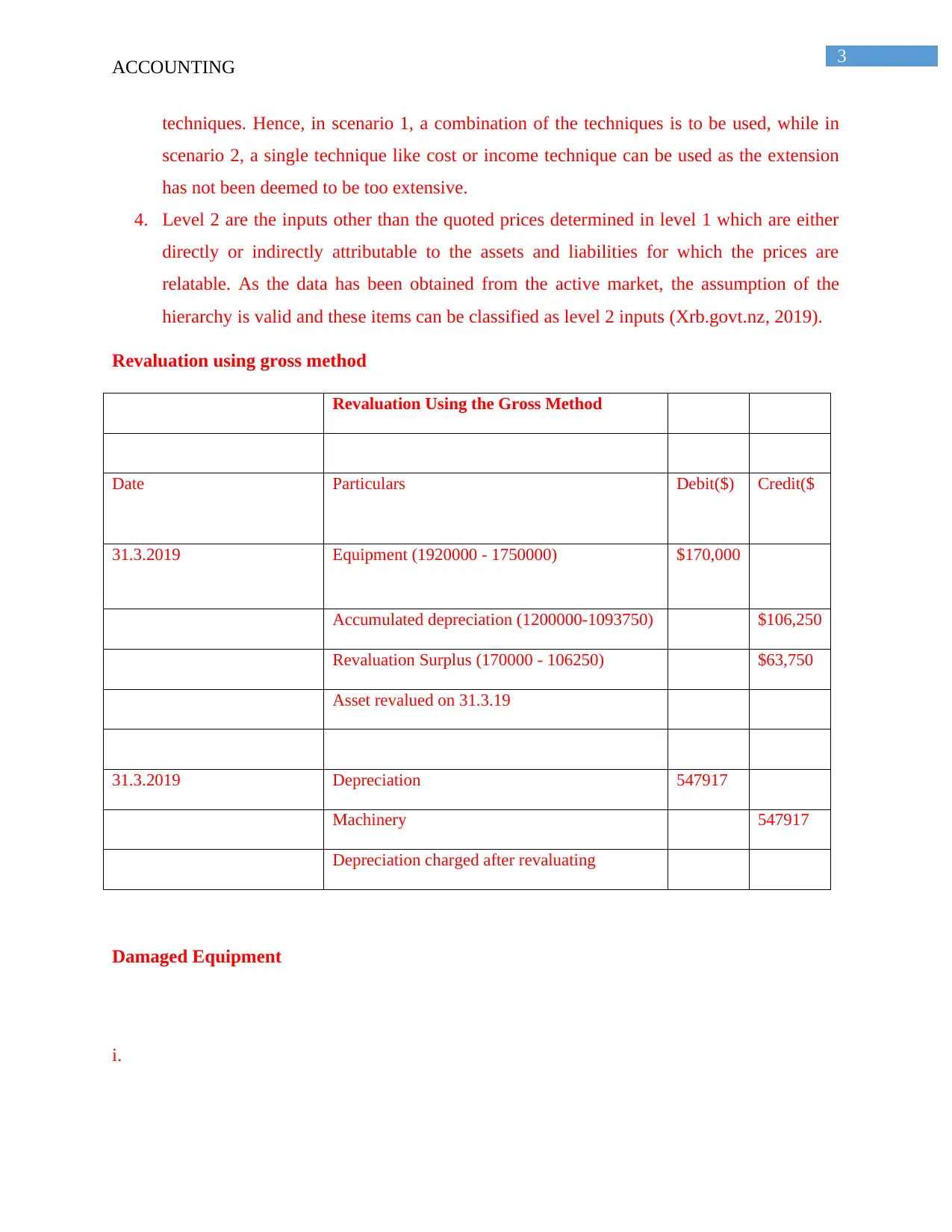
3
ACCOUNTING
techniques. Hence, in scenario 1, a combination of the techniques is to be used, while in
scenario 2, a single technique like cost or income technique can be used as the extension
has not been deemed to be too extensive.
4. Level 2 are the inputs other than the quoted prices determined in level 1 which are either
directly or indirectly attributable to the assets and liabilities for which the prices are
relatable. As the data has been obtained from the active market, the assumption of the
hierarchy is valid and these items can be classified as level 2 inputs (Xrb.govt.nz, 2019).
Revaluation using gross method
Revaluation Using the Gross Method
Date Particulars Debit($) Credit($
31.3.2019 Equipment (1920000 - 1750000) $170,000
Accumulated depreciation (1200000-1093750) $106,250
Revaluation Surplus (170000 - 106250) $63,750
Asset revalued on 31.3.19
31.3.2019 Depreciation 547917
Machinery 547917
Depreciation charged after revaluating
Damaged Equipment
i.
ACCOUNTING
techniques. Hence, in scenario 1, a combination of the techniques is to be used, while in
scenario 2, a single technique like cost or income technique can be used as the extension
has not been deemed to be too extensive.
4. Level 2 are the inputs other than the quoted prices determined in level 1 which are either
directly or indirectly attributable to the assets and liabilities for which the prices are
relatable. As the data has been obtained from the active market, the assumption of the
hierarchy is valid and these items can be classified as level 2 inputs (Xrb.govt.nz, 2019).
Revaluation using gross method
Revaluation Using the Gross Method
Date Particulars Debit($) Credit($
31.3.2019 Equipment (1920000 - 1750000) $170,000
Accumulated depreciation (1200000-1093750) $106,250
Revaluation Surplus (170000 - 106250) $63,750
Asset revalued on 31.3.19
31.3.2019 Depreciation 547917
Machinery 547917
Depreciation charged after revaluating
Damaged Equipment
i.
Paraphrase This Document
Need a fresh take? Get an instant paraphrase of this document with our AI Paraphraser
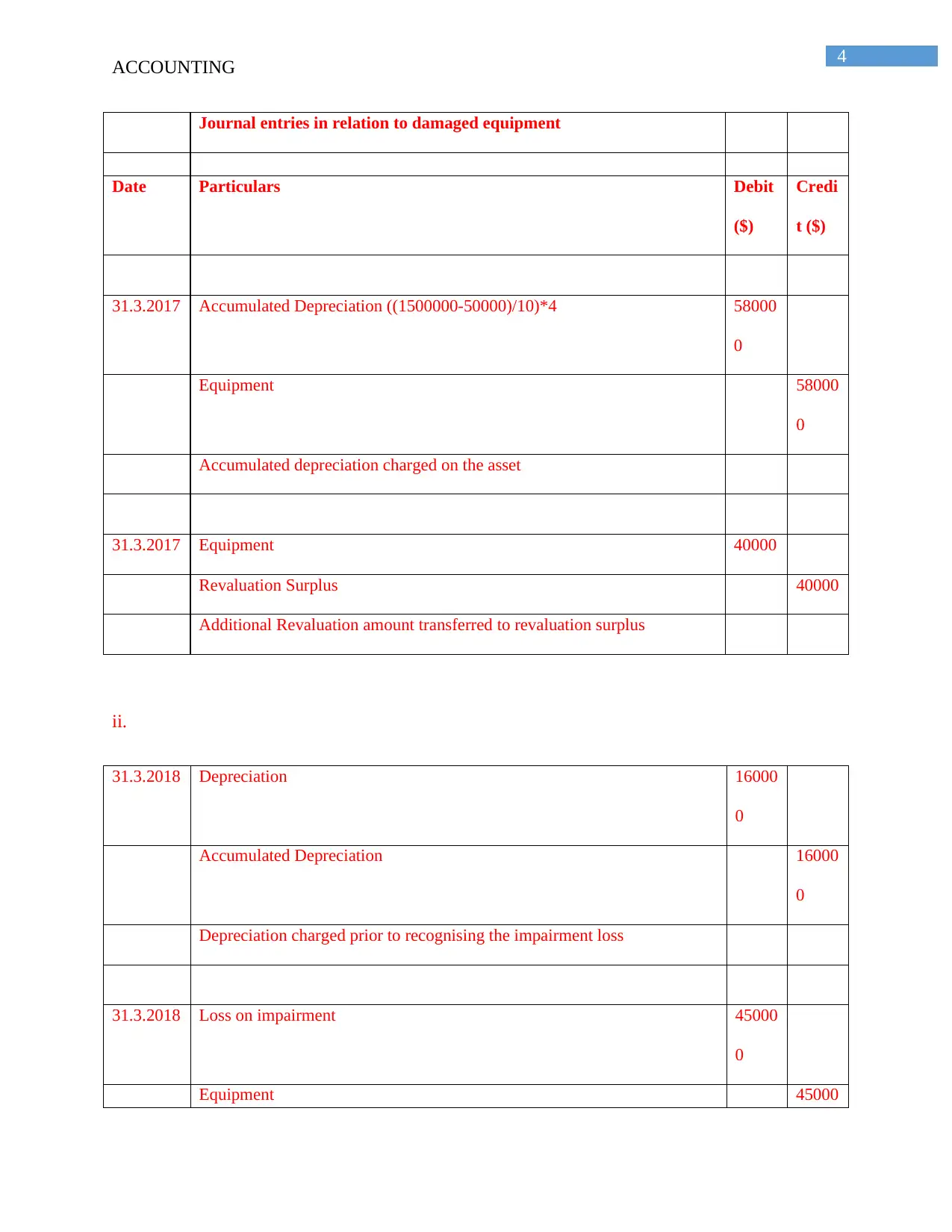
4
ACCOUNTING
Journal entries in relation to damaged equipment
Date Particulars Debit
($)
Credi
t ($)
31.3.2017 Accumulated Depreciation ((1500000-50000)/10)*4 58000
0
Equipment 58000
0
Accumulated depreciation charged on the asset
31.3.2017 Equipment 40000
Revaluation Surplus 40000
Additional Revaluation amount transferred to revaluation surplus
ii.
31.3.2018 Depreciation 16000
0
Accumulated Depreciation 16000
0
Depreciation charged prior to recognising the impairment loss
31.3.2018 Loss on impairment 45000
0
Equipment 45000
ACCOUNTING
Journal entries in relation to damaged equipment
Date Particulars Debit
($)
Credi
t ($)
31.3.2017 Accumulated Depreciation ((1500000-50000)/10)*4 58000
0
Equipment 58000
0
Accumulated depreciation charged on the asset
31.3.2017 Equipment 40000
Revaluation Surplus 40000
Additional Revaluation amount transferred to revaluation surplus
ii.
31.3.2018 Depreciation 16000
0
Accumulated Depreciation 16000
0
Depreciation charged prior to recognising the impairment loss
31.3.2018 Loss on impairment 45000
0
Equipment 45000
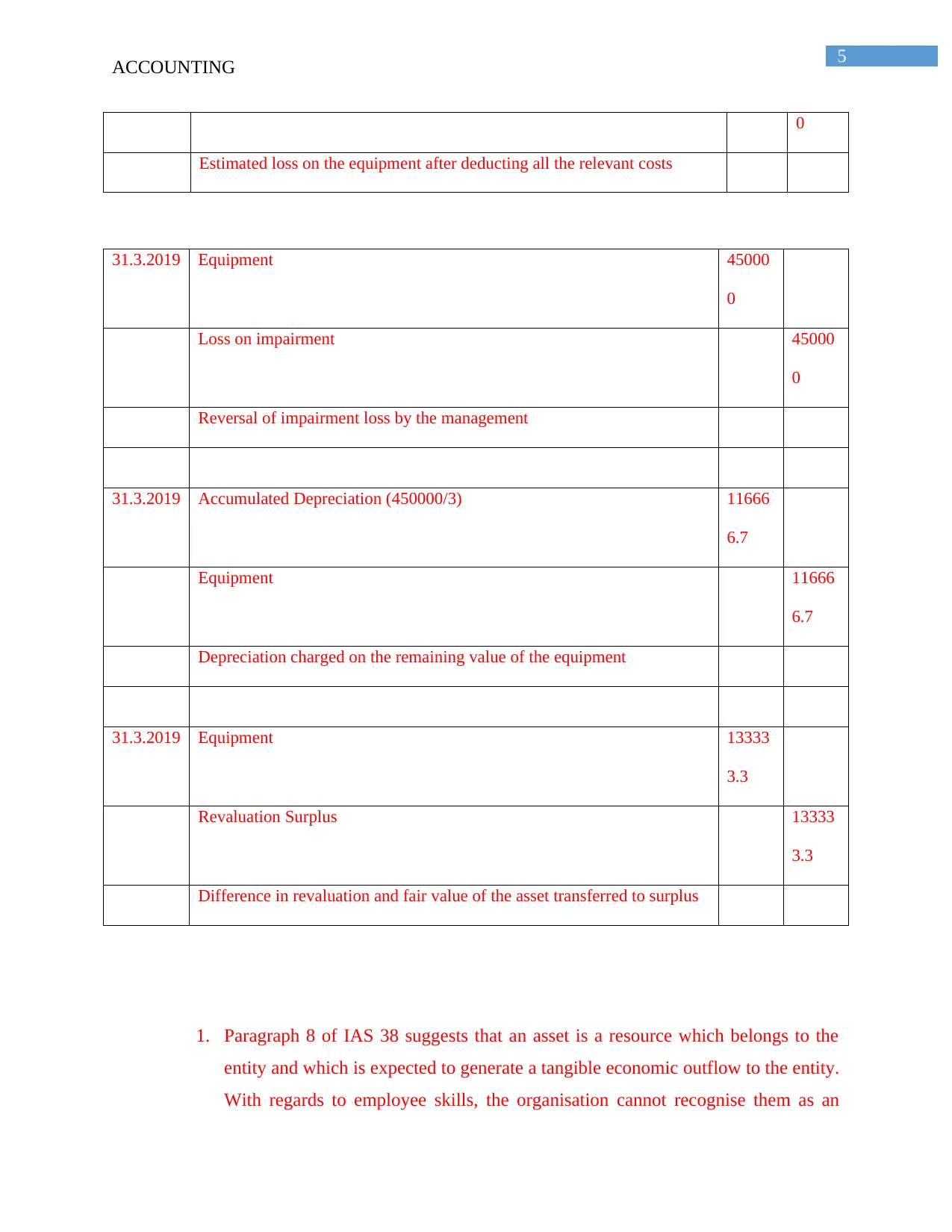
5
ACCOUNTING
0
Estimated loss on the equipment after deducting all the relevant costs
31.3.2019 Equipment 45000
0
Loss on impairment 45000
0
Reversal of impairment loss by the management
31.3.2019 Accumulated Depreciation (450000/3) 11666
6.7
Equipment 11666
6.7
Depreciation charged on the remaining value of the equipment
31.3.2019 Equipment 13333
3.3
Revaluation Surplus 13333
3.3
Difference in revaluation and fair value of the asset transferred to surplus
1. Paragraph 8 of IAS 38 suggests that an asset is a resource which belongs to the
entity and which is expected to generate a tangible economic outflow to the entity.
With regards to employee skills, the organisation cannot recognise them as an
ACCOUNTING
0
Estimated loss on the equipment after deducting all the relevant costs
31.3.2019 Equipment 45000
0
Loss on impairment 45000
0
Reversal of impairment loss by the management
31.3.2019 Accumulated Depreciation (450000/3) 11666
6.7
Equipment 11666
6.7
Depreciation charged on the remaining value of the equipment
31.3.2019 Equipment 13333
3.3
Revaluation Surplus 13333
3.3
Difference in revaluation and fair value of the asset transferred to surplus
1. Paragraph 8 of IAS 38 suggests that an asset is a resource which belongs to the
entity and which is expected to generate a tangible economic outflow to the entity.
With regards to employee skills, the organisation cannot recognise them as an
⊘ This is a preview!⊘
Do you want full access?
Subscribe today to unlock all pages.

Trusted by 1+ million students worldwide

6
ACCOUNTING
intangible asset due to its lack of control over the usage of the skills of the
employees and the economic benefits that can be obtained from them. Hence, as
per the paragraph 15 of IAS 38, the entity cannot recognise the skills as an
intangible asset unless it has a legal protection which allows it to use these skills
as an asset and measure the economic benefits obtained by it. This is the same
case with regards to customer loyalty, which cannot be recognised until it is
measurable or protected by a legal obligation.
2. Paragraph 75 of IAS 38 suggests that an intangible asset may be carried on a
revalued amount i.e. all amortisation expenses and losses deducted from the fair
value of an asset. This can be done only if the fair value of the intangible asset can
be arrived at by referring to an active and reliable market. Although it is very
uncommon for intangible assets, it is done in case of assets like tax licenses,
fishing licenses and quotas.
Usage of patents in the manufacturing process
As per paragraph 97 of IAS 38, the depreciable amount of an intangible asset with a
limited life shall be allocated on a systematic basis over the useful period of the life of the asset.
However, with regards to paragraph 104 of IAS 38, the amortisation period and the amortisation
method for each asset should be reviewed at the end of every financial year. In case of a change
in the useful life of the asset or an estimate of the economic assets that can be generated from an
asset, then the amortisation method should be changed to reflect a change in the estimates.
Hence, scenario 2 is correct and the company should change the amortisation method to reflect
the changes in the economic benefits that can be obtained from the patents.
Calculation of amortisation expense as on 31.3.2019
ACCOUNTING
intangible asset due to its lack of control over the usage of the skills of the
employees and the economic benefits that can be obtained from them. Hence, as
per the paragraph 15 of IAS 38, the entity cannot recognise the skills as an
intangible asset unless it has a legal protection which allows it to use these skills
as an asset and measure the economic benefits obtained by it. This is the same
case with regards to customer loyalty, which cannot be recognised until it is
measurable or protected by a legal obligation.
2. Paragraph 75 of IAS 38 suggests that an intangible asset may be carried on a
revalued amount i.e. all amortisation expenses and losses deducted from the fair
value of an asset. This can be done only if the fair value of the intangible asset can
be arrived at by referring to an active and reliable market. Although it is very
uncommon for intangible assets, it is done in case of assets like tax licenses,
fishing licenses and quotas.
Usage of patents in the manufacturing process
As per paragraph 97 of IAS 38, the depreciable amount of an intangible asset with a
limited life shall be allocated on a systematic basis over the useful period of the life of the asset.
However, with regards to paragraph 104 of IAS 38, the amortisation period and the amortisation
method for each asset should be reviewed at the end of every financial year. In case of a change
in the useful life of the asset or an estimate of the economic assets that can be generated from an
asset, then the amortisation method should be changed to reflect a change in the estimates.
Hence, scenario 2 is correct and the company should change the amortisation method to reflect
the changes in the economic benefits that can be obtained from the patents.
Calculation of amortisation expense as on 31.3.2019
Paraphrase This Document
Need a fresh take? Get an instant paraphrase of this document with our AI Paraphraser
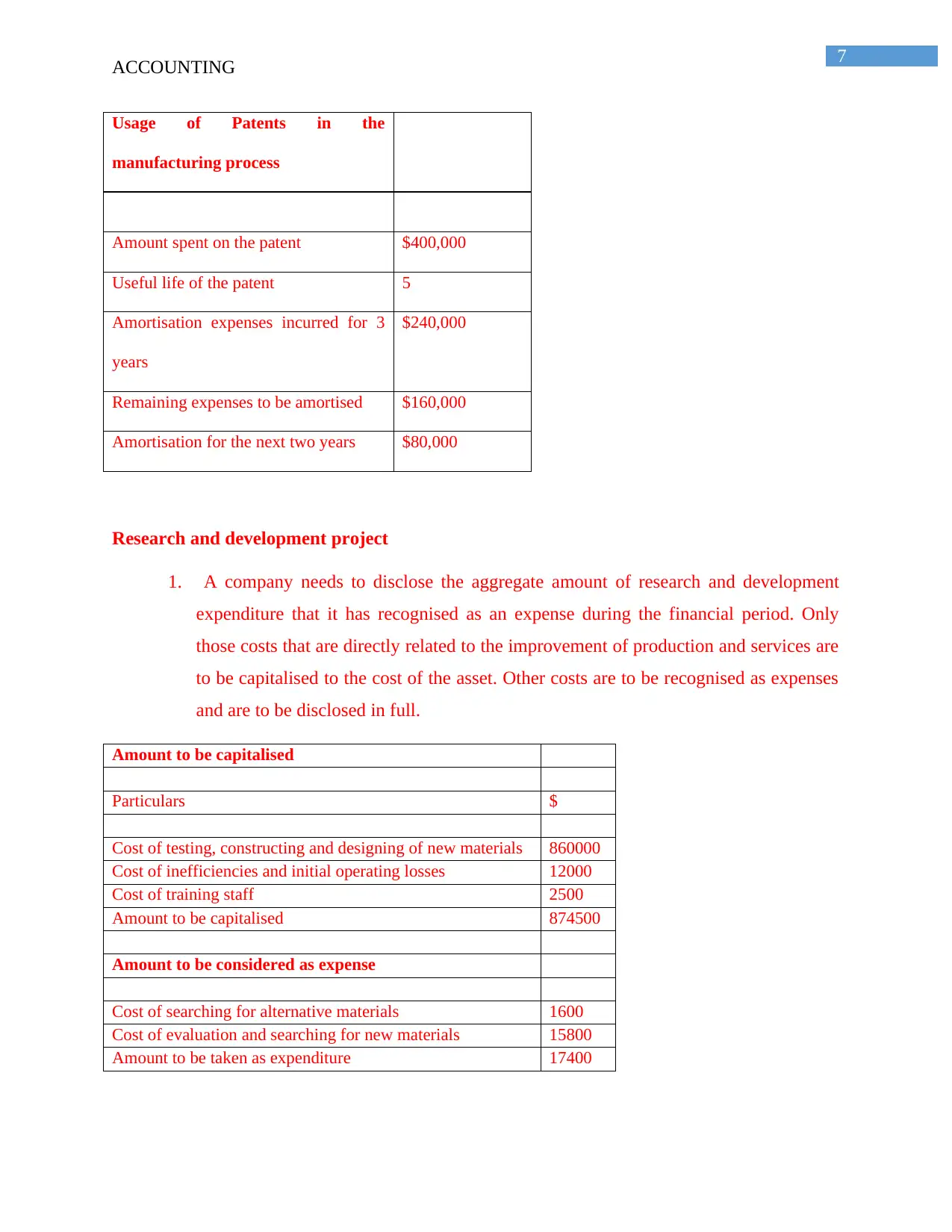
7
ACCOUNTING
Usage of Patents in the
manufacturing process
Amount spent on the patent $400,000
Useful life of the patent 5
Amortisation expenses incurred for 3
years
$240,000
Remaining expenses to be amortised $160,000
Amortisation for the next two years $80,000
Research and development project
1. A company needs to disclose the aggregate amount of research and development
expenditure that it has recognised as an expense during the financial period. Only
those costs that are directly related to the improvement of production and services are
to be capitalised to the cost of the asset. Other costs are to be recognised as expenses
and are to be disclosed in full.
Amount to be capitalised
Particulars $
Cost of testing, constructing and designing of new materials 860000
Cost of inefficiencies and initial operating losses 12000
Cost of training staff 2500
Amount to be capitalised 874500
Amount to be considered as expense
Cost of searching for alternative materials 1600
Cost of evaluation and searching for new materials 15800
Amount to be taken as expenditure 17400
ACCOUNTING
Usage of Patents in the
manufacturing process
Amount spent on the patent $400,000
Useful life of the patent 5
Amortisation expenses incurred for 3
years
$240,000
Remaining expenses to be amortised $160,000
Amortisation for the next two years $80,000
Research and development project
1. A company needs to disclose the aggregate amount of research and development
expenditure that it has recognised as an expense during the financial period. Only
those costs that are directly related to the improvement of production and services are
to be capitalised to the cost of the asset. Other costs are to be recognised as expenses
and are to be disclosed in full.
Amount to be capitalised
Particulars $
Cost of testing, constructing and designing of new materials 860000
Cost of inefficiencies and initial operating losses 12000
Cost of training staff 2500
Amount to be capitalised 874500
Amount to be considered as expense
Cost of searching for alternative materials 1600
Cost of evaluation and searching for new materials 15800
Amount to be taken as expenditure 17400

8
ACCOUNTING
2. As per the above calculations, the amount that is to be capitalised is to be added to the
cost of the asset whereas other costs are to be shown as an expenditure and to be
disclosed fully in the books of accounts at the end of the year.
ACCOUNTING
2. As per the above calculations, the amount that is to be capitalised is to be added to the
cost of the asset whereas other costs are to be shown as an expenditure and to be
disclosed fully in the books of accounts at the end of the year.
⊘ This is a preview!⊘
Do you want full access?
Subscribe today to unlock all pages.

Trusted by 1+ million students worldwide
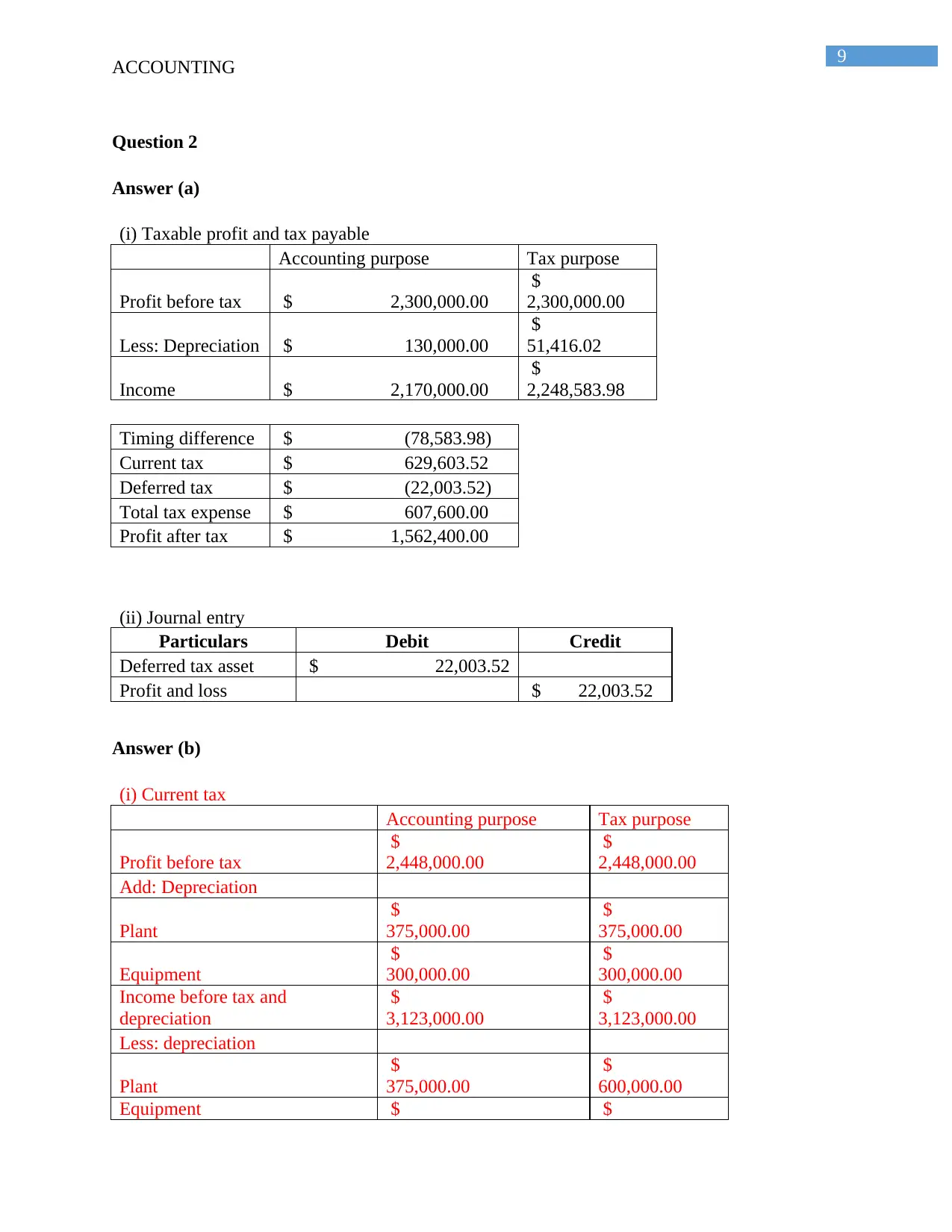
9
ACCOUNTING
Question 2
Answer (a)
(i) Taxable profit and tax payable
Accounting purpose Tax purpose
Profit before tax $ 2,300,000.00
$
2,300,000.00
Less: Depreciation $ 130,000.00
$
51,416.02
Income $ 2,170,000.00
$
2,248,583.98
Timing difference $ (78,583.98)
Current tax $ 629,603.52
Deferred tax $ (22,003.52)
Total tax expense $ 607,600.00
Profit after tax $ 1,562,400.00
(ii) Journal entry
Particulars Debit Credit
Deferred tax asset $ 22,003.52
Profit and loss $ 22,003.52
Answer (b)
(i) Current tax
Accounting purpose Tax purpose
Profit before tax
$
2,448,000.00
$
2,448,000.00
Add: Depreciation
Plant
$
375,000.00
$
375,000.00
Equipment
$
300,000.00
$
300,000.00
Income before tax and
depreciation
$
3,123,000.00
$
3,123,000.00
Less: depreciation
Plant
$
375,000.00
$
600,000.00
Equipment $ $
ACCOUNTING
Question 2
Answer (a)
(i) Taxable profit and tax payable
Accounting purpose Tax purpose
Profit before tax $ 2,300,000.00
$
2,300,000.00
Less: Depreciation $ 130,000.00
$
51,416.02
Income $ 2,170,000.00
$
2,248,583.98
Timing difference $ (78,583.98)
Current tax $ 629,603.52
Deferred tax $ (22,003.52)
Total tax expense $ 607,600.00
Profit after tax $ 1,562,400.00
(ii) Journal entry
Particulars Debit Credit
Deferred tax asset $ 22,003.52
Profit and loss $ 22,003.52
Answer (b)
(i) Current tax
Accounting purpose Tax purpose
Profit before tax
$
2,448,000.00
$
2,448,000.00
Add: Depreciation
Plant
$
375,000.00
$
375,000.00
Equipment
$
300,000.00
$
300,000.00
Income before tax and
depreciation
$
3,123,000.00
$
3,123,000.00
Less: depreciation
Plant
$
375,000.00
$
600,000.00
Equipment $ $
Paraphrase This Document
Need a fresh take? Get an instant paraphrase of this document with our AI Paraphraser
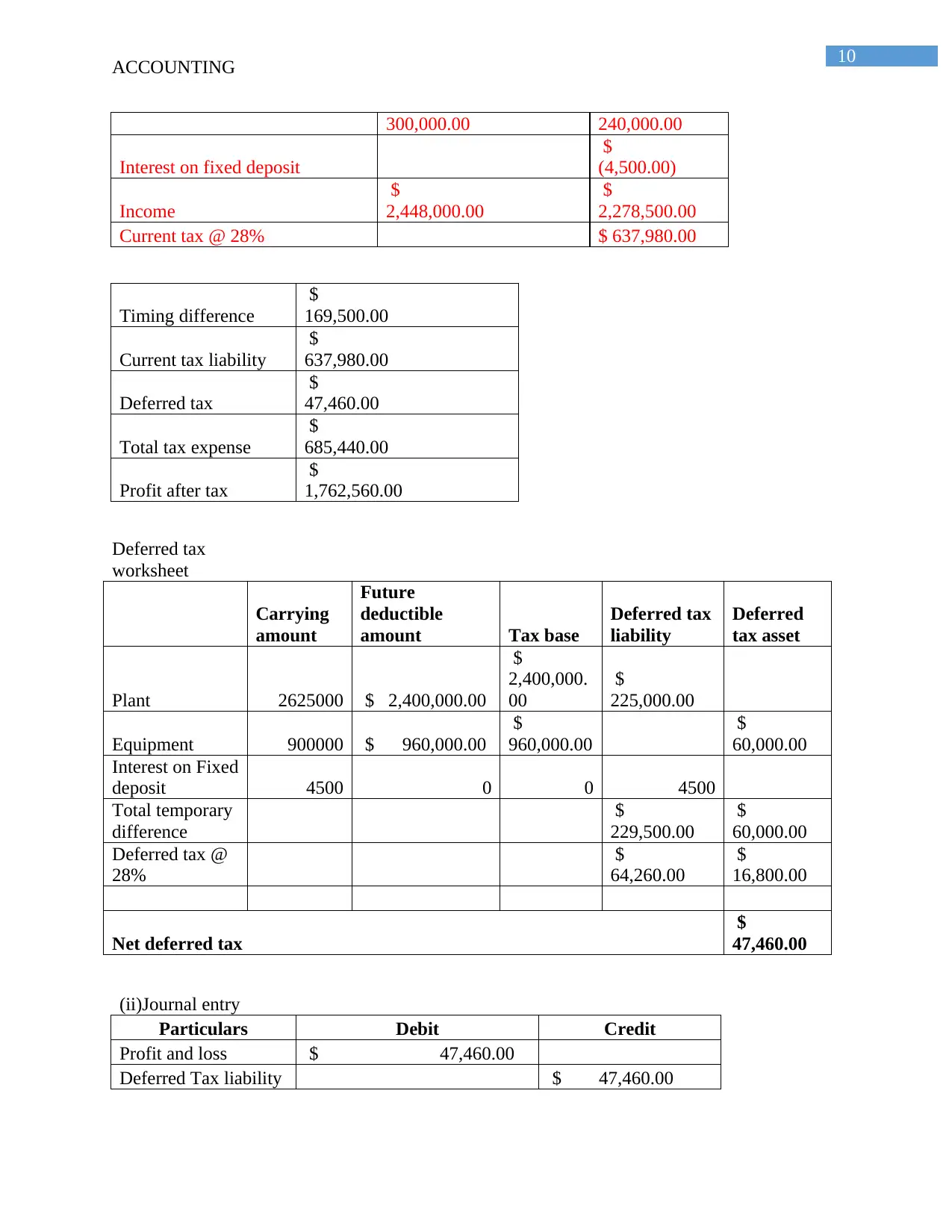
10
ACCOUNTING
300,000.00 240,000.00
Interest on fixed deposit
$
(4,500.00)
Income
$
2,448,000.00
$
2,278,500.00
Current tax @ 28% $ 637,980.00
Timing difference
$
169,500.00
Current tax liability
$
637,980.00
Deferred tax
$
47,460.00
Total tax expense
$
685,440.00
Profit after tax
$
1,762,560.00
Deferred tax
worksheet
Carrying
amount
Future
deductible
amount Tax base
Deferred tax
liability
Deferred
tax asset
Plant 2625000 $ 2,400,000.00
$
2,400,000.
00
$
225,000.00
Equipment 900000 $ 960,000.00
$
960,000.00
$
60,000.00
Interest on Fixed
deposit 4500 0 0 4500
Total temporary
difference
$
229,500.00
$
60,000.00
Deferred tax @
28%
$
64,260.00
$
16,800.00
Net deferred tax
$
47,460.00
(ii)Journal entry
Particulars Debit Credit
Profit and loss $ 47,460.00
Deferred Tax liability $ 47,460.00
ACCOUNTING
300,000.00 240,000.00
Interest on fixed deposit
$
(4,500.00)
Income
$
2,448,000.00
$
2,278,500.00
Current tax @ 28% $ 637,980.00
Timing difference
$
169,500.00
Current tax liability
$
637,980.00
Deferred tax
$
47,460.00
Total tax expense
$
685,440.00
Profit after tax
$
1,762,560.00
Deferred tax
worksheet
Carrying
amount
Future
deductible
amount Tax base
Deferred tax
liability
Deferred
tax asset
Plant 2625000 $ 2,400,000.00
$
2,400,000.
00
$
225,000.00
Equipment 900000 $ 960,000.00
$
960,000.00
$
60,000.00
Interest on Fixed
deposit 4500 0 0 4500
Total temporary
difference
$
229,500.00
$
60,000.00
Deferred tax @
28%
$
64,260.00
$
16,800.00
Net deferred tax
$
47,460.00
(ii)Journal entry
Particulars Debit Credit
Profit and loss $ 47,460.00
Deferred Tax liability $ 47,460.00
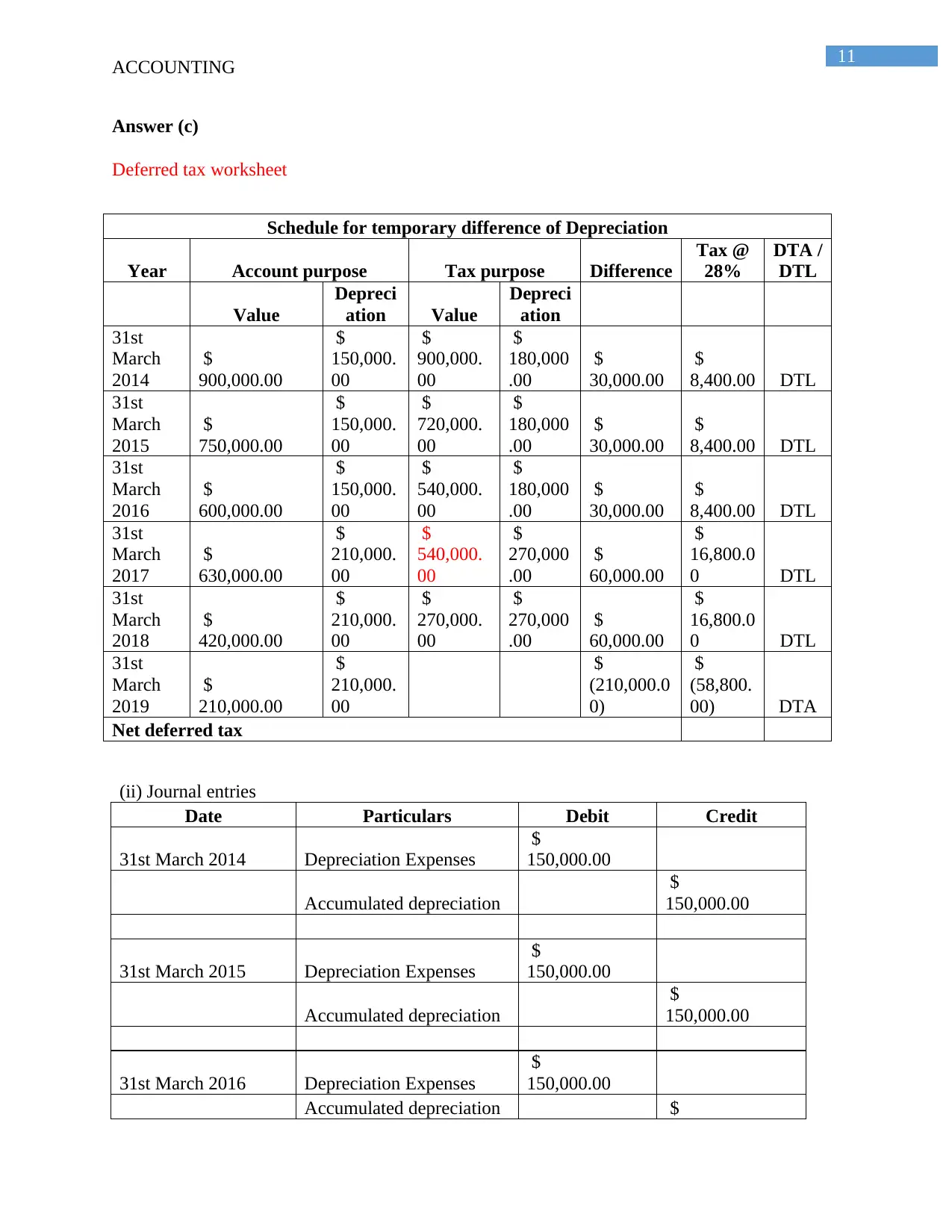
11
ACCOUNTING
Answer (c)
Deferred tax worksheet
Schedule for temporary difference of Depreciation
Year Account purpose Tax purpose Difference
Tax @
28%
DTA /
DTL
Value
Depreci
ation Value
Depreci
ation
31st
March
2014
$
900,000.00
$
150,000.
00
$
900,000.
00
$
180,000
.00
$
30,000.00
$
8,400.00 DTL
31st
March
2015
$
750,000.00
$
150,000.
00
$
720,000.
00
$
180,000
.00
$
30,000.00
$
8,400.00 DTL
31st
March
2016
$
600,000.00
$
150,000.
00
$
540,000.
00
$
180,000
.00
$
30,000.00
$
8,400.00 DTL
31st
March
2017
$
630,000.00
$
210,000.
00
$
540,000.
00
$
270,000
.00
$
60,000.00
$
16,800.0
0 DTL
31st
March
2018
$
420,000.00
$
210,000.
00
$
270,000.
00
$
270,000
.00
$
60,000.00
$
16,800.0
0 DTL
31st
March
2019
$
210,000.00
$
210,000.
00
$
(210,000.0
0)
$
(58,800.
00) DTA
Net deferred tax
(ii) Journal entries
Date Particulars Debit Credit
31st March 2014 Depreciation Expenses
$
150,000.00
Accumulated depreciation
$
150,000.00
31st March 2015 Depreciation Expenses
$
150,000.00
Accumulated depreciation
$
150,000.00
31st March 2016 Depreciation Expenses
$
150,000.00
Accumulated depreciation $
ACCOUNTING
Answer (c)
Deferred tax worksheet
Schedule for temporary difference of Depreciation
Year Account purpose Tax purpose Difference
Tax @
28%
DTA /
DTL
Value
Depreci
ation Value
Depreci
ation
31st
March
2014
$
900,000.00
$
150,000.
00
$
900,000.
00
$
180,000
.00
$
30,000.00
$
8,400.00 DTL
31st
March
2015
$
750,000.00
$
150,000.
00
$
720,000.
00
$
180,000
.00
$
30,000.00
$
8,400.00 DTL
31st
March
2016
$
600,000.00
$
150,000.
00
$
540,000.
00
$
180,000
.00
$
30,000.00
$
8,400.00 DTL
31st
March
2017
$
630,000.00
$
210,000.
00
$
540,000.
00
$
270,000
.00
$
60,000.00
$
16,800.0
0 DTL
31st
March
2018
$
420,000.00
$
210,000.
00
$
270,000.
00
$
270,000
.00
$
60,000.00
$
16,800.0
0 DTL
31st
March
2019
$
210,000.00
$
210,000.
00
$
(210,000.0
0)
$
(58,800.
00) DTA
Net deferred tax
(ii) Journal entries
Date Particulars Debit Credit
31st March 2014 Depreciation Expenses
$
150,000.00
Accumulated depreciation
$
150,000.00
31st March 2015 Depreciation Expenses
$
150,000.00
Accumulated depreciation
$
150,000.00
31st March 2016 Depreciation Expenses
$
150,000.00
Accumulated depreciation $
⊘ This is a preview!⊘
Do you want full access?
Subscribe today to unlock all pages.

Trusted by 1+ million students worldwide
1 out of 22
Related Documents
Your All-in-One AI-Powered Toolkit for Academic Success.
+13062052269
info@desklib.com
Available 24*7 on WhatsApp / Email
![[object Object]](/_next/static/media/star-bottom.7253800d.svg)
Unlock your academic potential
Copyright © 2020–2025 A2Z Services. All Rights Reserved. Developed and managed by ZUCOL.





